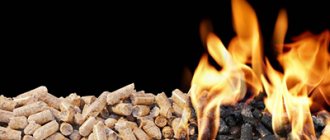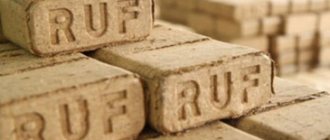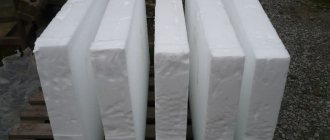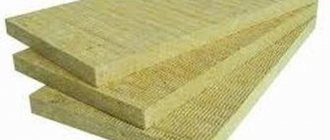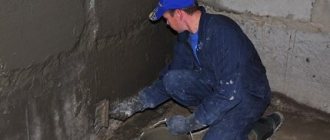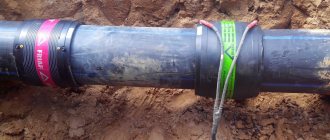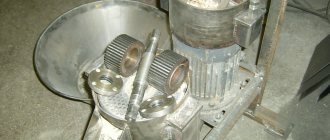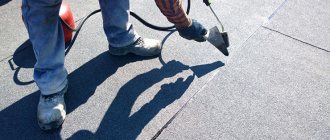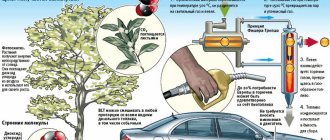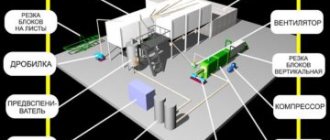What are pellets?
Pellets
are a granular type of solid fuel, cylindrical in shape, made from compressed waste from agricultural production and the woodworking industry. The main materials for the manufacture of fuel pellets are:
- sawdust, wood chips, bark, slabs of coniferous and deciduous (the best option) wood species;
- peat;
- sunflower husks (the most common solution), rapeseed (the best option), straw of various grain crops, corn, husks, cake and much more;
- charcoal;
- household waste.
The base binder is a substance of plant origin - lignin, a natural polymer contained in almost any plant, capable of being plasticized during granulation under the influence of a sufficiently high operating temperature.
Technological stages of pellet production
The pellet production technology involves several production stages, at the first of which small wood waste in the form of sawdust and shavings is delivered via a conveyor and poured into a special warehouse equipped with a moving floor. The reciprocating movements of the wedge-shaped moving floor stockers are carried out by means of a hydraulic drive, as a result of which sawdust is fed at a constant speed to a chain, scraper conveyor.
The main purpose of the scraper conveyor is to feed wood shavings and sawdust into a special device – a mixer and a drying drum. Another fuel conveyor present in the production line ensures partial selection of sawdust with its subsequent supply to the fuel bunker of the heat generator.
From the fuel bunker, sawdust is fed through a screw into the combustion chamber of the heat generator. Through the vacuum created by the exhaust fan, the movement of cold atmospheric air and raw materials transferred for drying is formed. Combustion products are mixed with cold air, with automatic adjustment of mixing proportions to maintain the required coolant temperature. After which the coolant is mixed with wet raw materials and enters the drum dryer.
From the dryer drum, the raw materials are captured by special blades and fed upward, passing through the coolant flow to the outlet, behind which a special stone catcher is installed, which enters the raw materials from the dumps, as a result of the absence of a sorting process for incoming raw materials. Upon completion of the drying procedure, sawdust is fed into a huge cyclone using the vacuum method created by a smoke exhauster, where, under the influence of centrifugal force, it settles and moves downward, while the spent coolant is discharged into a special chimney.
Pellet classification
The main regulatory document predetermining the production of pellets is the European Union standard EN 14961-2, adopted in January 2011, on its basis an international quality certificate EN Plus is issued. There are three classes of granular fuel:
- ENPlus-A1 – best premium quality, diameter up to 8.00 mm, ash content up to 0.70%, another name is “white granules”;
- ENPlus-A2 – with ash content up to 1.50%, also called industrial granules, can consist of mixed wood species;
- EN-B – standard quality, with ash content up to 3.00%, an alternative name for agropellets.
In terms of cost, the most expensive pellets are ENPlus-A1 class, the cheapest are EN-B class, it is better not to take substandard fuel.
What standards are used to determine the quality of finished pellets?
All domestic pellet producers today use quality standards that are accepted in most European countries. Foreign manufacturers of solid fuel for pellet boilers must obtain certificates of conformity for their products in accordance with the quality standards in force in the European Union. If such a document is missing, then this circumstance scares away buyers. The EN plus and EN-B quality standards set out the requirements for both household and industrial pellets according to several criteria. These include: diameter, length, bulk density, calorific value, humidity, abrasion or dust percentage, hardness, ash content, ash melting point, content of metals and other chemical elements.
Basic parameters of pellets
Pellets for heating are granules of white or shades of brown, with a length from 10.00 to 30.00 mm, a diameter of 6.00 and 8.00 mm, less common fuel with a diameter of 10.00 mm, the maximum diameter of the granules is 25.00 mm. The darkening of pellets is associated with the presence in the structure of the material of various non-combustible residues (dust, earth, and a number of others).
The main parameters of pellets are:
- ash content (the lower, the better and the less ash, so the boiler will have to be cleaned much less often);
- humidity;
- calorific value (ENPlus-A1 – 18.0 MJ/kg, ENPlus-A2 – 18.0 MJ/kg, EN-B – 15.0 MJ/kg).
- total length;
- degree of density;
- diameter;
- bulk mass;
- abrasion class.
Classification of pellets and their characteristics
At first, one variety could be found on sale, and there were no distinctions.
But as they say, time does not stand still, and even such a simple material has acquired several types, classified by type of application:
White pellet
Highest grade (premium). The production uses clean wood chip waste without bark and resinous secretions, which allows you to leave a minimum of ash after combustion. The calorific value of this product is 17.2 MJ/kg. In production and sale on the market, they make up 95% of all products and are used in any heating stoves and for household needs.
Industrial pellets
A lower quality product, as evidenced by its purpose. They are used only in boiler room furnaces, and cannot be used at home. The presence of fireproof residues and tree bark in the composition affects the ash content. And if we talk about heat capacity, it is almost the same as white pellets.
Agropellets
This is a standard type of fuel made from industrial waste and sunflower seeds, buckwheat and other combustion products. They are used in large boiler houses that heat small villages or private houses, which is facilitated by a high calorific value of 15 MJ/kg. The ash content of 3% and residues can clog the air ducts, so when using them, periodic cleaning is recommended, or better yet, the use of a special boiler exclusively for heating with agropellets.
Characteristics
Pellets are presented in the form of small pressed round-shaped cylinders, with varying diameters of a maximum of 25 mm. 6-10 mm granules are in particular demand. This form ensures the flowability of the fuel, allowing them to be used with any automated feeding devices existing today in boiler rooms.
Pellet manufacturing technology
The production of pellets consists of pressing waste that has been previously dried to a certain moisture content and crushed to a given fraction under a pressure of about 300 atmospheres. At the same time, the use of glue and other additives is prohibited (sometimes unscrupulous businessmen add sand and other non-combustible impurities to them to increase the weight of the granules, and synthetic polymers to ensure adhesive properties).
Main stages of pellet production:
- Grinding. The raw material enters the crusher and is crushed to a given fraction;
- Drying. The resulting raw material is dried to the moisture percentage specified by the technology (about 10% plus or minus 2%);
- Pressing. The dried raw material enters a press granulator, in which it is pressed into granules of a given length and diameter. As a result of compression, friction, and adiabatic processes, the temperature can reach 100°C Celsius, as a result, thermal energy is generated that softens lignin and the particles stick together into granules. This process is called pelletization;
- Cooling. To ensure the strength of the fuel granules, the pellets are cooled after pressing;
- Packing and sending to the consumer.
In some cases, water treatment and additional grinding are performed before pressing; everything directly depends on the type and quality of the raw materials from which the granules are made. Pressing is carried out in molds, ring-type dies using rotary rollers (rollers), which press the raw material into cone-shaped dies located on the matrix. On the other hand, the resulting granules are cut with special knives. After cooling, the pellets are sieved and small particles are sent for recycling. Closed cycle technology is virtually waste-free; only non-combustible impurities are removed. In order to make one ton of pellets, three to five cubes of wood waste are needed. The raw material is compacted approximately three times. To prepare one ton of pellets you need from 30.00 to 50.00 kW per hour.
Production technology
The first stage in the production of this type of fuel is the coarse crushing of raw materials, for which special units are used. Depending on the variety, its composition and weight may vary. The resulting particles must have a volume of no more than 1.25 cm3. At the next stage, drying occurs (the fact is that, according to technology, the moisture content of the raw materials before pressing should not exceed 12 percent).
Next, the resulting product is crushed to such an extent that the particles have a size of no more than 1.5 millimeters for the first grade and up to 4 millimeters for the industrial type. After this, water treatment of the raw materials is carried out. Its essence lies in the fact that overdried particles must be brought to the required condition. This is due to the fact that when the moisture content of the raw material is less than 8 percent, the particles practically do not stick together under the action of the press.
The key stage that granular fuel goes through during production is its pressing. For this process, various press installations are used, equipped with a cylindrical or flat matrix. To dry the overheated granules, they are cooled at the very end. The production of this type of fuel ends with sifting (this is necessary to prevent the granules from sticking together) and packaging. Such production is very profitable, since all waste generated is simply recycled.
Necessary machines for the production of pellets
Equipment for the production of sawdust pellets includes:
- crushers (chopping machines) for grinding the raw materials used to a given fraction;
- dryers to ensure the required percentage of humidity of the initial, base raw materials;
- hammer mills (in some cases they are replaced by flaring machines, disintegrators, everything depends directly on the characteristics of the feedstock), make it possible to obtain raw materials with a fraction of up to 4.00 mm;
- screw mixers (used when using overdried raw materials with a moisture content of less than 8.00%, by dosed supply of steam or water);
- presses (differ in the type of matrix used, which can be flat or round).
Dryers, in turn, are divided into:
- principle of operation (can be drum or belt (cost more, but are more productive and safer to use));
- drying technologies (using flue gases, water vapor or hot air);
- the fuel used (gas, wood waste, coal, etc.).
To burn pellets, special equipment is used - a pellet boiler.
.
The optimal solution in terms of price/quality/performance ratio on the Russian market is heating appliances from the Polish manufacturer Metal-Fach, including boilers from the SD DUO
,
SD DUO BIO
,
SMART
,
SMART EKO
,
SEG, SEG BIO
.
They have a steel heat exchanger (P265GH steel with a thickness of 4.00 to 6.00 mm is used for production), an efficiency of over 90%, an innovative, modern type controller FL 310LGRTC
, with continuous logic and PID control, as well as an upper combustion chamber and a retort type burner.
Also worthy offers are:
- domestic boilers created in Krasnoyarsk, ZOTA
Pellet
series ; - joint development of the Russian-Polish company Vulkan
, the
EKO
; - pellet boilers from the legendary Italian company FACI
Caldaie,
FACI SSL/SSP
.
You can purchase pellet boilers in a wide range, get the necessary advice, order installation, warranty and post-warranty service in Krasnoyarsk from the Kras-Kotel company.
Pellet production as a business
The production of fuel pellets is a strictly raw material-oriented process
And a very important part of it is the uninterrupted delivery of materials for processing. Pellets can be made from several materials
The production of pellets from sawdust allows you to obtain granules of the highest quality. They have maximum heat transfer during combustion and the longest combustion life. High quality and characteristics make them the most expensive among all types of fuel pellets. The production of pellets from straw provides the cheapest type of biological fuel. Such granules have low heat transfer and burn out very quickly. In practice, mixed pellets are very often produced, which consist of several types of waste.
The production of biological fuel is a very promising area of business. In Europe, many enterprises and utilities have already expressed a desire to switch to fuel pellets. Therefore, the demand for pellets will increase annually, which will allow consistently high profits. To open your own business producing fuel pellets, you must first study the demand. If there are potential clients, you need to start looking for suppliers of raw materials. Next, logistics comes into play, which will help you choose a location for the plant with convenient transportation so that travel costs are minimal.
It is not necessary to build technological structures from scratch. You can rent a suitable premises and equip it for production. This will save a lot of time and effort. Mini pellet production can be set up right at the sawmill. You just need to come to an agreement with its management and equip the workplace. Such proximity will make it possible to completely avoid transport costs for the delivery of raw materials. There will also be no problems with supply disruptions due to weather conditions, such as heavy snowfalls or icy roads, which can interfere with long-distance travel. Well, when all the issues regarding suppliers and clients are settled, you need to get start-up capital, obtain the necessary licenses and you can safely start your own business.
How to distinguish high, premium quality pellets from substandard fuel?
When purchasing pellets, you need to pay attention to:
- the surface of the material must be smooth, shiny, without signs of deformation (swelling and microcracks);
- diameter (this parameter is established by the standards, the minimum value is 4.00 mm, the maximum is 10 mm, also standard are fuel pellets that have a diameter of 6.00 and 8.00 mm, please note that a pellet boiler operates on pellets of a certain fraction);
- length (this parameter should be about 20.00 - 30.00 mm, this is the optimal value, although the equipment can work on pellets with a length of over 50.00 mm);
- smell (the granules should have a slightly sweet smell of freshly prepared glue, this is a clear sign of excellent quality);
- color (it is important to remember that the highest quality pellets are white or slightly cream-colored, agropellets are predominantly dark, and in wood pellets, dark color indicates that bark, other impurities have been added, or wood species have been mixed);
- dust (there should be a minimum amount of dust on pellets, so it is better to buy fuel in sealed packaging);
- impurities (the presence of non-combustible impurities in the granules themselves can only be checked by burning them and determining the residue in the form of solid particles).
Pellet moisture content
Many consumers who use fuel pellets understand when burning that the moisture content of the pellets directly affects the efficiency and calorific value.
The initial humidity depends only on the manufacturer; normally it should vary between 7-9%. After receiving the fuel, the consumer must take care of storing the pellets, since this determines how good they will be when used.
It is advisable that the pellets be covered with a sealed film that does not allow moisture and water to pass through. Liquid is the most that can harm them.
If you conduct an experiment and pour a small amount of water into a bag with granules, then after a couple of minutes they begin to swell, and after a while, sawdust forms in place of the dense “cylinders”. After 5 minutes, due to expansion, the bag becomes tight and heavy, and the pellets turn into mush, which can no longer become fuel.
The humidity of pellets during storage should remain the same as after production. Therefore, you cannot leave them outside without covering material, since precipitation in the form of rain or snow will definitely ruin the quality. If, however, there is no separate room for storage, then more material should be added to the original packaging; this will protect the pellets if one of the layers breaks.
Why do wood pellets expand and swell when they come into contact with water? This is due to the production itself. First, the raw materials are dried so that the moisture content of the pellets is optimal, and then they are compressed in a granulator. Typically, at a suitable compression ratio to produce premium wood pellets, sawdust volume is reduced by approximately 6:1.
Also read news on this topic
- Pellets inexpensively
- Pellets in St. Petersburg
- Pellets 6 mm
- Buy pellets 8 mm
Wood pellets are made with a high density and low moisture content, so they sort of “seek” it to absorb it. The hydrophilic properties mean they can also be used for purposes other than fuel. For example, as bedding for farm animals or as cat litter.
Some consumers store their bags of pellets in a basement or shed. Although these rooms are protected from rain and other precipitation, they tend to be quite damp and damp. Therefore, if fuel is left open or there are cuts in the packaging, the pellets will absorb moisture from the air. As a result, they will turn into the same mush as if you poured water on them, only it will take more time.
If it so happens that the fuel gets wet and the moisture content of the pellets has increased significantly, then it is not recommended to burn them. Wet pellets will struggle to ignite and create more smoke, ash and possibly even creosote.
They produce fuel pellets that comply with GOST, have the correct humidity, ash content, calorific value and other characteristics. To ensure quality, get free samples to test. For all questions, call the phone number: +7 (831) 339-14-60 or write by email
Advantages and disadvantages of solid fuel in the form of fuel pellets
The main advantages of pellets:
- environmental cleanliness (when burning this type of solid fuel, carbon dioxide is released in volumes equal to the volumes formed during the natural decomposition of various wood wastes);
- fire safety (pellets are less susceptible to spontaneous combustion than other types of solid fuel);
- optimal humidity (8-10% versus 30-50% for logs) and density (one and a half times higher than that of firewood);
- remarkable calorific value, one ton of fuel pellets is enough to produce 3500 kW/h of thermal energy;
- constant and very high bulk density, which facilitates logistics, loading and transportation of pellets;
- the uniformity of the structure in shape and size makes it possible to automate all processes of loading and loading and combustion of fuel pellets in boilers.
Cons of pellets:
- high cost of solid fuel at the present stage;
- to burn pellets you need a special pellet boiler equipped with automation, which also costs more;
- the volume of supply on the market is low, the situation will improve over time, but pellets must be purchased in reserve and stored in warehouses, preventing excess moisture from entering.
Pellet production in Russia
Features of the production and consumption of fuel pellets in the Russian Federation, the capabilities of this innovative type of fuel and the trade offer for the supply of pellets.
There are many variants of names for fuel pellets on the market: new generation firewood, fuel pellets, biofuel... Fuel pellets, invented in the mid-20th century, every year arouse more and more interest among consumers all over the world, including in Russia. Russian manufacturers appreciated the opportunity to use wood processing waste not so long ago, but high consumer demand stimulated the active development of industry in this area.
What are wood pellets?
Fuel pellets are small cylindrical granules with a diameter of 6-8 mm, pressed from crushed waste, in most cases wood processing. Also, to produce cheap fuel pellets, some manufacturers use waste from cereal production, straw and husks.
The listed raw materials are crushed, dried and pressed. Pressing causes the wood flour to heat up, causing the wood lingin to glue the particles together. Finished granules are sold in bulk, in bags and sacks with a volume of 2 to 50 kg, in big bags with a capacity of up to 1.2 tons.
Advantages of fuel pellets
Comparing thermal pellets with wood, gas, coal and oil, you can find that biomass is superior to fossil fuels and firewood in most respects:
- — the calorific value of wood is 1.5 times less,
- — after burning pellets, no more than 1–3% of ash remains from the volume of fuel, this is 15–20 times less than from the combustion of oil and gas,
- — the cost of wood pellets is lower than that of the same volume of traditional types of fuel,
- - due to the absence of dust, pellets do not self-ignite,
- — there are no spores in the granules, so they are safe for people with pollen allergies,
- — the standard size of pellets allows you to automate their packaging, feeding into the boiler, loading, unloading, transportation, minimizing manual labor and the “human factor”.
Production of wood pellets in Russia
The Russian wood pellet market has shown stable growth since its inception (over the period 2008–2017, its volume increased approximately 7 times). Production volumes, exports of the product, and its use in the country are growing, although the share of exports still makes up the majority of the volumes - about 80%. All of Europe buys Russian pellets, the main consumer being the Scandinavian countries and Great Britain with their cold climate.
Despite the huge forest area in the country, Russia ranks only 8th in the world in terms of pellet exports and 3rd among exporters of pellets to Europe. Only 25% of wood waste in the country is processed into biofuel, and for agricultural waste the percentage is even lower.
Granules are produced in all regions: from Arkhangelsk to Vladivostok. The majority is produced by the Northwestern Federal District, accounting for up to 60% of the production of fuel pellets - due to its proximity to Europe and international seaports. The production of fuel pellets is gradually developing in the Far East and Siberia for consumers from Korea and Japan, where Western technologies are being actively introduced and “green” energy enterprises are being subsidized.
In total, there are more than 250 pellet factories in Russia with a total capacity of up to 3.5 million tons per year. These are wood processing plants, for which the production of biofuels is an additional source of income, and specialized industries that use third-party raw materials.
In the Russian Federation there is a standard for the production of biofuel pellets GOST R 54220-2010. The most popular granule diameters in the country are 6 and 8 mm; some enterprises produce products with a diameter of 4 and 12 mm. Fuel with an ash content of up to 3% is produced for industry, and up to 1% for private consumers.
Pellet cost
Let's take the initial data:
- the average cost of industrial pellets in the Krasnoyarsk Territory as of December 2015 is 3,500 rubles per ton (3.50 per kilogram);
- the price of birch firewood is 1,300 rubles per cubic meter, in terms of tons (a cubic meter of dry birch firewood equals 650 kg of weight) is 1,846 rubles per ton (1.85 rubles per kilogram);
- the calorific value of birch firewood is 10 MJ/kg;
- The calorific value of wood industrial pellets is 18 MJ/kg.
In order to obtain 100 MJ of thermal energy, you need 10 kg of firewood (100/10), that is, 18.50 rubles, or 5.5 kg of pellets (100/18), that is, 19.44 rubles. The difference in cost is 1 ruble per 100 MJ. Moreover, it is necessary to note the undoubted advantages of pellets with an ash content of 1.5% over firewood with an ash content of 10%, the difference is obvious. It should be taken into account that the pellet market is growing dynamically, and with an increase in supply, the price will undoubtedly decrease. By the way, pellets can be made independently from agricultural or wood waste. Read below how.
Where are wood pellets used?
The main use of pellets remains the production of thermal energy during their combustion. The efficiency of this material is greater than that of coal and natural gas and is 95%. Even the remaining ash is used to reduce soil acidity in agriculture. This property is used for space heating and water heating in solid fuel boilers.
To automate the process of the next portion of pellets entering the combustion chamber, special pellet boilers are produced. The principle of its operation is based on the constant supply of fuel from the storage hopper to the combustion chamber through a rotating screw. The rotation speed is calculated based on the combustion time of the portion in the chamber. Such a mechanism is necessary when organizing space heating as a continuous process.
Wood flour pellets are used for more than just warmth. They have a high ability to absorb liquid media. Therefore, they are used in other industries:
- In animal husbandry, as an environmentally friendly bedding material.
- In fuel production as an absorbent.
- To eliminate emergency situations to collect pollutants.
- For filler of gas purification filters from sulfur.
- For fuel of barbecues.
- As cat litter.
We make pellets with our own hands
You can make pellets with your own hands. To do this we need to assemble a granulator. It is necessary to take wood or agricultural waste, grind it to a particle fraction of 30.00-50.00 mm, dry it to a moisture content of 15.00%, grind it to particles with a fraction of 2.00 mm and place it in a granulator. In the case when you use agricultural waste, such as sunflower husks, rapeseed or sawdust, as the initial, basic raw material, you do not need to crush anything. But if branches, bark, or various substandard lumber are used, it is necessary to crush, although the use of a granulator allows you to omit this operation. The dryer is made from an ordinary metal barrel. It is better to use a granulator with a flat matrix (a cylindrical matrix in the shape of a perforated drum is a more complex solution) and a perforated disk with outlet holes in the shape of a cone with a diameter of 8.00-10.00 mm, this is the optimal solution. You need to buy a matrix and rollers (the production of spare parts is carried out by manufacturers of equipment for the production of animal feed). The matrix is also made independently, from steel with a thickness of at least 20.00 mm, and gears are used as rollers. You will also need a gearbox and an electric motor with a power equal to or greater than 15.00 kW. It is necessary to ensure rotation in the range of 60-120 revolutions per minute. The shaft can be installed both horizontally and vertically; the main thing is to make tanks for loading the raw materials and subsequent unloading of pellets.
Stages of making pellets:
- we take or make a matrix, make a hole in the center for the gearbox and always a groove intended for landing;
- gears (rollers can be used, the width of which must match the width of the working surface of the matrix used), are put on the shaft strictly perpendicular to the axis of the installed gearbox shaft using a conventional coupling;
- the cylindrical body is welded from sheet steel or steel pipe, taking into account the dimensions of the matrix, which should rotate easily and freely, providing holes for unloading pellets and a tray also made of sheet steel or steel pipe, the bottom and top of the structure can be made detachable to facilitate maintenance;
- the output shaft of the selected gearbox is strengthened in the lower part of the machine using a coupling and always bearings;
- the matrix, as well as the rollers, are installed in a cylindrical body;
- the resulting structure is mounted on a frame made of a channel or an ordinary angle and is rigidly fastened; all that remains is to install the engine and connect the output shaft to the installed gearbox.
The future belongs to pellets and pellet boilers. Kras-Kotel specialists will help you make the right choice of pellet boiler, taking into account all your wishes and the characteristics of your home.
Share on social media networks:
Production of thermal granules
The process of producing wood pellets can be divided into industrial and artisanal production.
Factory production
The technological process of producing fuel pellets in a factory consists of several stages using special machines:
The raw material enters the large parts shredder to produce wood chips.- This material in the drying chamber, under the influence of hot air, is freed from excess moisture. Normally, it is necessary to achieve 10% moisture saturation for further production.
- The dried mass enters the apparatus for grinding it into wood flour.
- The wood grinding is delivered to the pressing unit. It is a mechanism consisting of two drums rotating in different directions with perforated walls and a pressing shaft that squeezes the contents of the chamber through the holes in the walls. The entire process of obtaining high-quality material occurs under the influence of high temperatures, reaching values of 3000C. This temperature is necessary to separate lingin resin from the raw material. It produces bonding of the composition.
- The resulting granules at the next stage undergo a cooling process using cold air. At the same time, this air flow cleans the material from unbound wood flour and sends it for recycling. The granules in their mass are pure objects.
- The final stage of production of fuel pellets is their packaging in sealed plastic packaging.
Independent production
Wood pellets can be produced with your own hands using two machines:
- Converter of large pieces of wood into sawdust.
- Pressing machine. It consists of a heavy shaft with gears at the ends and a pressing chamber. At its base there is a perforated sheet of metal. The shaft is driven by an electric motor. When rotating, the gears further crush the raw materials. Under pressure, material in the form of granules is extruded through a perforated sheet. The friction produced by the gears on the sawdust causes the wood to heat up and release resin to bond the substance.
